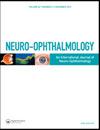虚拟现实视界和静态自动视界在各种神经眼科疾病中的一致性:一项试点研究
IF 0.8
Q4 CLINICAL NEUROLOGY
引用次数: 0
摘要
目的是比较虚拟现实视界(VRP)(数量级,OM)和静态自动视界(SAP)在各种神经眼科疾病中的一致性。我们对2022年1月1日至5月31日期间使用VRP和SAP进行视野测试的各种神经眼科疾病患者的视野图进行了回顾性分析。两位训练有素的神经眼科医生比较了两种装置上观察到的视野缺陷。百分数一致被用来比较两位审查员对两种技术的解释。148例患者(平均年龄44岁,17-74岁)的160只眼睛符合研究标准。最常见的病因是各种原因引起的视神经萎缩、视神经炎、缺血性视神经病变和压缩性视神经病变。总的来说,我们发现VRP和SAP在双颞(93.8%)、偏视(90.8%)、纵向(79.4%)和广义视野缺陷(86.4%)方面有很好的一致性。该协议是可以接受的中央/中心盲区暗瘤和不接受扩大的盲点。在两位审查员之间,双颞缺陷(92.3%)、偏视缺陷(82%)、纵向缺陷(83%)和广泛性视野缺陷(76.4%)有很好的一致性。我们的研究结果表明,VRP在各种神经-眼科疾病,特别是那些可能产生偏视、纵向和广泛性视野缺陷的情况下,与SAP总体上一致。这在各种情况下都很有用;然而,未来需要更大规模的研究来探索现实世界的利用。我们感谢验光团队成员(Masuma, Fatima, Aleena Saji, Gowthami Neredimilli, Mounika Vadithya和Saurav Ghosh,他们帮助我们招募患者并收集数据),以及我们在技术创新中心的团队,他们在各个技术方面提供了帮助。披露声明作者未报告潜在的利益冲突。本研究由海德拉巴眼科研究基金会提供的校内资金支持。本文章由计算机程序翻译,如有差异,请以英文原文为准。
Agreement Between Virtual Reality Perimetry and Static Automated Perimetry in Various Neuro-Ophthalmological Conditions: A Pilot Study
ABSTRACTOur objective was to compare the agreement between virtual reality perimetry (VRP) (order of magnitude, OM) and static automated perimetry (SAP) in various neuro-ophthalmological conditions. We carried out a retrospective analysis of visual field plots of patients with various neuro-ophthalmological conditions who underwent visual field testing using VRP and SAP and between 1 January and 31 May 2022. Two fellowship-trained neuro-ophthalmologists compared the visual field defects observed on both devices. Per cent agreement was used to compare the interpretation of the two examiners on both techniques. The study criteria were met by 160 eyes from 148 patients (mean age 44 years, range 17–74 years). The most common aetiologies were optic atrophy due to various causes, optic neuritis, ischaemic optic neuropathy, and compressive optic neuropathy. Overall, we found good agreement between VRP and SAP for bitemporal (93.8%), hemianopic (90.8%), altitudinal (79.4%), and generalised visual field defects (86.4%). The agreement was acceptable for central/centrocaecal scotomas and not acceptable for enlarged blind spots. Between the two examiners there was good agreement for bitemporal (92.3%), hemianopic (82%), altitudinal (83%), and generalised field defects (76.4%). The results of our study suggest that VRP gives overall good agreement with SAP in various neuro-ophthalmological conditions, especially those likely to produce hemianopic, altitudinal, and generalised visual field defects. This could be useful in various settings; however, future larger studies are needed to explore real-world utilisation.KEYWORDS: Agreementvirtual realityperimetrystandard automated perimetryneuro-ophthalmology AcknowledgmentsWe thank our optometry team members (namely Masuma, Fatima, Aleena Saji, Gowthami Neredimilli, Mounika Vadithya, and Saurav Ghosh, who helped us with enrolment of the patients, and collected the data), and our team at Centre for Technology Innovation, who helped with various technical aspects.Disclosure statementNo potential conflict of interest was reported by the authors.Additional informationFundingThis study is supported by the intramural funding provided by Hyderabad Eye Research Foundation.
求助全文
通过发布文献求助,成功后即可免费获取论文全文。
去求助
来源期刊

Neuro-Ophthalmology
医学-临床神经学
CiteScore
1.80
自引率
0.00%
发文量
51
审稿时长
>12 weeks
期刊介绍:
Neuro-Ophthalmology publishes original papers on diagnostic methods in neuro-ophthalmology such as perimetry, neuro-imaging and electro-physiology; on the visual system such as the retina, ocular motor system and the pupil; on neuro-ophthalmic aspects of the orbit; and on related fields such as migraine and ocular manifestations of neurological diseases.
 求助内容:
求助内容: 应助结果提醒方式:
应助结果提醒方式:


